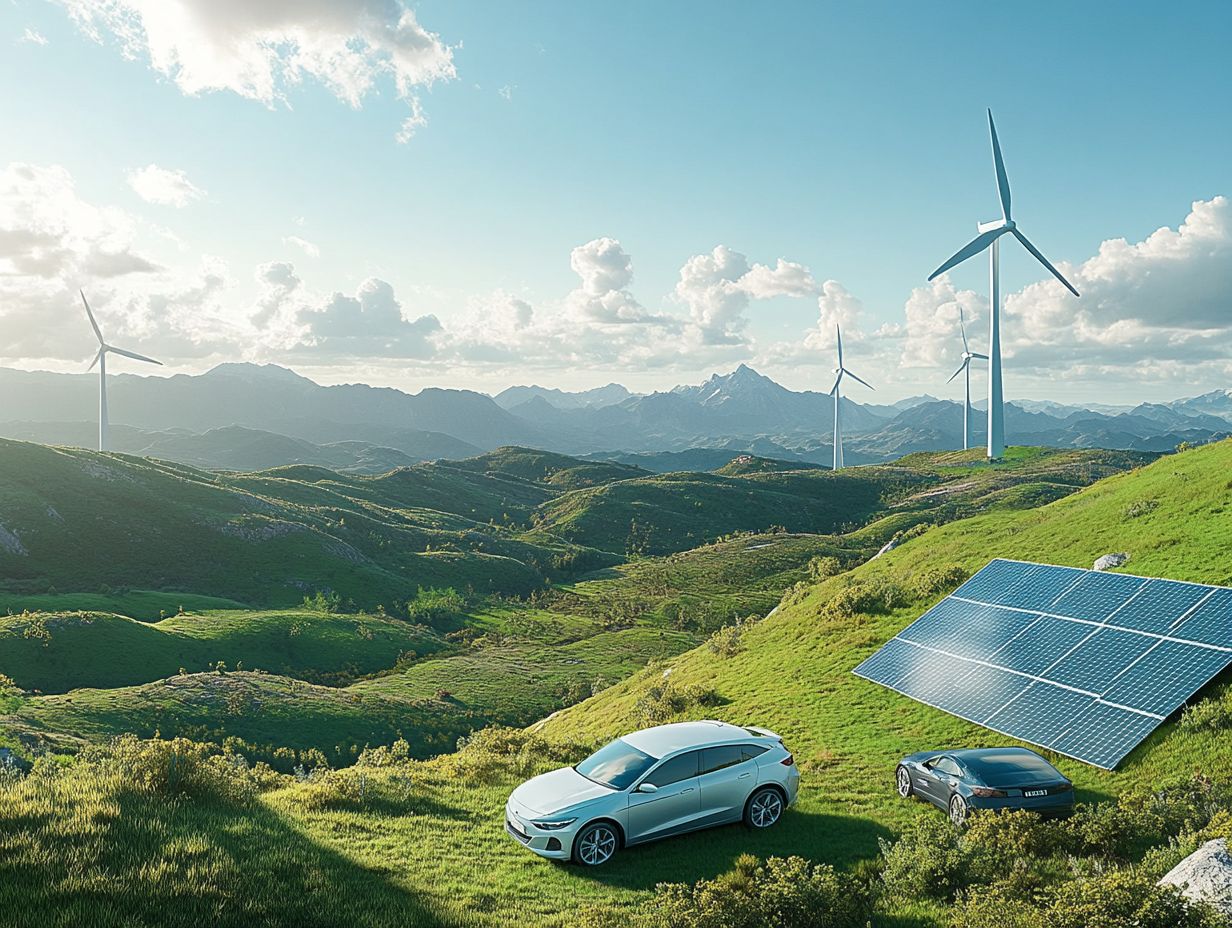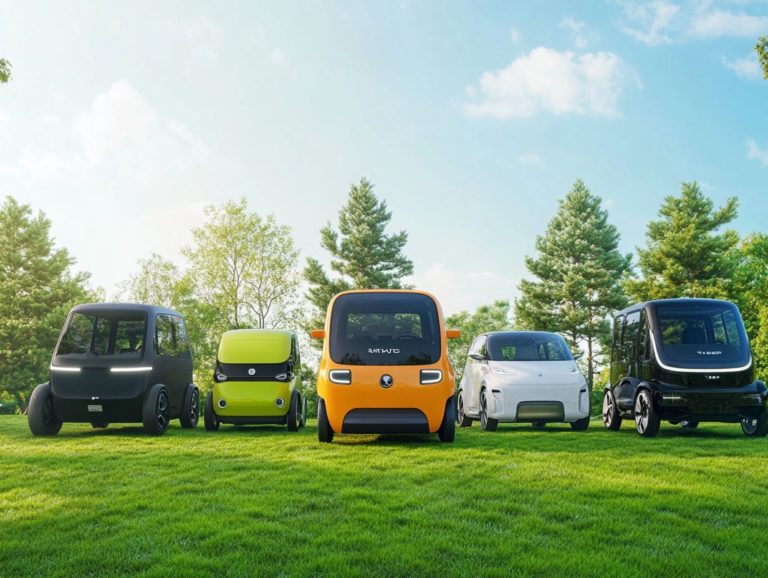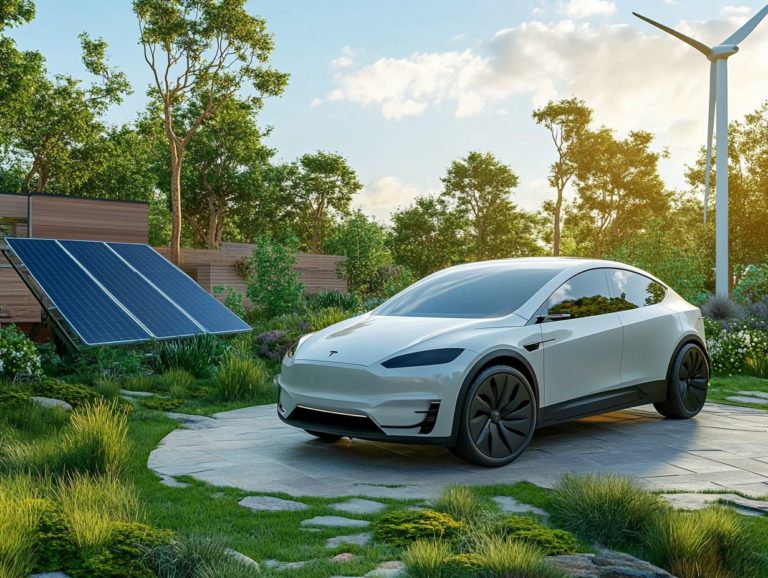The Relationship Between EVs and Renewable Energy
As the world embraces a more sustainable future, you ll find that electric vehicles (EVs) and renewable energy sources are at the forefront of this transformation.
This article delves into the synergy between these two groundbreaking innovations, shedding light on their environmental and economic advantages, as well as the challenges currently faced and the prospects that lie ahead.
From the benefits they bring to the obstacles they encounter, you’ll discover how their integration has the potential to reshape our energy landscape.
Explore the exciting relationship between EVs and renewable energy and discover how it can impact your life.
Contents
- Key Takeaways:
- Benefits of EVs and Renewable Energy
- Challenges and Limitations
- The Future of EVs and Renewable Energy
- How EVs and Renewable Energy Work Together
- Frequently Asked Questions
- What is the relationship between EVs and renewable energy?
- How do EVs contribute to the use of renewable energy?
- Can EVs be charged using renewable energy sources?
- How do EVs and renewable energy reduce carbon emissions?
- Is the relationship between EVs and renewable energy sustainable?
- How does this relationship impact the environment?
Key Takeaways:

- EVs and renewable energy offer both environmental and economic benefits.
- Despite current challenges, potential solutions are being developed to enhance the integration of EVs and renewable energy.
- The future looks promising for the growth and impact of EVs and renewable energy on society.
What are EVs and Renewable Energy?
Electric Vehicles (EVs) embody a transformative vision for sustainable transportation, harnessing renewable energy sources such as solar and wind to greatly reduce reliance on fossil fuels and significantly cut greenhouse gas emissions. As cities like Austin and Portland embrace the EV revolution, integrating clean energy into our energy systems becomes paramount for achieving a balance where carbon emissions are eliminated or offset and enhancing energy efficiency across vehicle fleets.
This evolution also includes the infrastructure necessary for long-term support. Charging stations powered by renewable energy are pivotal in this transition, smoothing the path for broader EV adoption.
Organizations like Austin Energy and Pacific Gas & Electric are spearheading initiatives to expand charging networks, simplifying the switch to electric for drivers. These efforts amplify the overall environmental impact of EVs by ensuring they are fueled by cleaner energy, presenting an eco-friendly alternative to traditional vehicles that heavily depend on fossil fuels.
Benefits of EVs and Renewable Energy
The integration of electric vehicles and renewable energy offers you a wealth of advantages. You can expect significant reductions in emissions, enhanced energy efficiency, and a step toward a carbon-neutral future.
Over time, this synergy not only promotes a cleaner environment but also contributes to a more sustainable world for all.
Environmental and Economic Advantages
The shift towards electric vehicles powered by renewable energy presents you with both environmental and economic benefits. You’ll enjoy reduced energy costs and enhanced operational efficiency for your transportation needs, as these vehicles make optimal use of charging stations and advanced energy management technologies.
By integrating renewable sources like solar and wind, electric vehicles significantly decrease transportation emissions. This shift not only fosters a healthier environment but also actively combats climate change. You ll find that these vehicles offer an eco-friendly alternative that’s also financially savvy for both individuals and businesses.
While the initial investment in renewable-powered vehicles might seem daunting, it can lead to substantial long-term savings through lower operational costs and various incentives for adopting energy-efficient technologies. Plus, with an expanding network of accessible charging options, you’ll appreciate the convenience of reliable refueling, making the switch to cleaner transportation solutions even more appealing.
Challenges and Limitations

Despite the substantial benefits of electric vehicles and renewable energy, several challenges and limitations remain. Challenges include insufficient charging infrastructure, integration hurdles with existing energy systems, and behavioral patterns that affect EV adoption rates.
Current Obstacles and Potential Solutions
Current hurdles in integrating electric vehicles with renewable energy include the charging network, energy storage challenges, and the need for improved infrastructure to support widespread adoption.
Limited energy storage capabilities make it hard to manage the intermittent nature of renewable resources. This intermittency can cause fluctuations, destabilizing the energy supply.
Many charging networks remain sparse, especially in rural areas. This can create a sense of range anxiety among potential EV users.
Advancements in battery technologies, like solid-state batteries, could enhance energy storage efficiency and reduce costs. Investing in charging infrastructure led by major players such as Google and Amazon could improve accessibility significantly.
Government policies that encourage renewable energy use and the development of smart grids are essential for integrating these technologies into daily life.
The Future of EVs and Renewable Energy
The future of electric vehicles and renewable energy looks promising. It is driven by technological advancements and increased investment in charging infrastructure.
Smart charging solutions are set to optimize energy consumption across vehicle fleets. This creates opportunities for growth and innovation.
Expected Growth and Impact on Society
The expected growth of the electric vehicle market and renewable energy will significantly impact society. Expect cleaner air and reduced greenhouse gas emissions.
As electric vehicles gain popularity, more people will prioritize eco-friendly choices. This shift will also drive job creation in manufacturing and infrastructure development.
A transition to electric transportation can reduce reliance on fossil fuels, enhancing energy security. Advancements in battery technologies will make renewable-powered vehicles more appealing to consumers.
This movement towards sustainable mobility promises environmental benefits and a new wave of economic vitality.
How EVs and Renewable Energy Work Together

The relationship between electric vehicles and renewable energy sources is crucial for a sustainable transportation ecosystem. By combining these technologies, we create an energy generation process that is efficient and environmentally friendly, highlighting why EVs are crucial for a sustainable future.
Integration and Synergy
Integrating electric vehicles into energy systems increases the viability of renewable energy sources. This promotes efficient energy production and consumption.
This collaboration maximizes the use of solar and wind energy, which can be inconsistent. It also optimizes electric vehicle charging times to match peak renewable energy generation.
With advanced charging infrastructure, smart grid technologies, and demand response systems, you can charge your vehicle during off-peak hours. This approach minimizes reliance on fossil fuels.
Innovations in energy storage, especially through vehicle-to-grid technology, allow you to draw energy and feed it back into the grid. This two-way energy exchange boosts grid stability and responsiveness.
Frequently Asked Questions
What is the relationship between EVs and renewable energy?
EVs run on electricity, which can be generated from renewable sources like solar, wind, and hydro. This makes them a greener choice compared to gasoline-powered vehicles.
How do EVs contribute to the use of renewable energy?

EVs create a demand for clean electricity. As more people drive EVs, we need more renewable energy, which helps reduce reliance on non-renewable sources.
Can EVs be charged using renewable energy sources?
Yes! EVs can be charged with solar panels or wind energy. This ensures a completely clean energy cycle, from production to driving.
How do EVs and renewable energy reduce carbon emissions?
EVs eliminate the need for fossil fuels in transportation. By using renewable electricity, they don’t emit harmful pollutants, playing a vital role in lowering carbon emissions.
Is the relationship between EVs and renewable energy sustainable?
Absolutely! The growth of both industries ensures that clean energy for transportation will continue to expand as technology advances.
How does this relationship impact the environment?
The synergy between EVs and renewable energy positively impacts our planet. It helps reduce carbon emissions, minimizes pollution, and improves overall environmental health.






